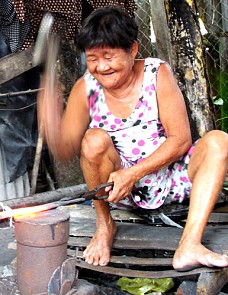Blacksmithing is traditionally the job of men as it is hard work, involving extreme heat, and dangerous tools, but this is not so in Loc Trat Village in the southern Tay Ninh Province, Vietnam.
The most skilled and experienced blacksmiths of the village are women, who have been working much longer than the average male blacksmith. At the village in Tan Loc Hamlet (Gia Loc Commune, Trang Bang District), women in their 60s are still physically fit enough to work with a 3kg hammer for hours while their male counterparts cannot.
However, the practice of blacksmithing has been gradually disappearing because of the availability of modern tools and machines, and of easier jobs in factory production lines.
Nowadays, elderly people who are refused work in factories turn to the traditional art for their livelihood. Thus, furnaces at Loc Trat are mainly operated by elderly women.
Female strength
Before factories were built around Loc Trat many years ago, the village boasted 90 percent of its working population involved in the blacksmithing field, or 400 households and over a thousand people. Now it has no more than 50 households that contain blacksmiths, according to Le Thanh Ngai, vice chief of the Tan Loc Hamlet.
Under an eave leaking drops of rain water by the side of her house, Ms. Nguyen Thi Dieu, 61, was taking advantage of the cool weather to forge several sickles for an order.
“I can only hammer in late evening and at night. It’s too hot to forge in the day by the burning furnace,” said Dieu.
Her husband Tran Van Khich, sits by the hot furnace to control the heat and adjust the iron piece so that his wife strikes on the right place to forge the metal into a knife or other tool.
The beating drums of a hammer on an anvil sound like a tune played by musical instruments. Added to the tune is the hissing of the boiling hot metal placed in a water cistern for cooling. Blacksmiths heat, forge, and cool the metal to improve the hardness and elasticity of the tool.
Ms. Dieu can hammer for hours without a sign of exhaustion.
Mr. Khich admitted that “Blacksmithing reveals who is stronger in old age. For the past five years, I haven’t been able to work with a hammer, while my wife is still working every day with a 3kg one.”
“Women are really more durable than men,” he added.
Pausing after hammering nine iron rods into thin blades to make sickles, Ms. Dieu said, “Actually, my strength is decreasing. Before I could work with hammers of four or five kilograms but now I can only use this 3kg one.”
She joked that she was born by a furnace so she is strong and learned how to forge when she was still inside her mother’s belly.
Ms. Dieu is now a senior smith in Loc Trat. She trained her husband in the career after marrying him decades ago, but her sons and daughters didn’t follow their parents’ path.
“When they visit us, they ask us to stop doing such hard labor. They say they can support us. But my husband and I told them that we will stop when we can’t lift up a hammer,” Ms. Dieu said.
A fading career
Experienced smiths in Loc Trat cite many reasons why they keep their children away from the traditional career. The work is hard; it doesn’t pay well; sales have been down since factories have opened, and their youth and beauty faded quickly with time spent by the furnace.
Ms. Ha Thi Oanh, in her 70s, and her husband Nguyen Van Co, 80, said they are left with no valuable assets despite working for half a century.
“It takes two hours to forge a metal rod into a big curved knife to sell for VND60,000 [US$3] but material and coal cost over VND40,000. Before, we could make several knives a day but now I’m lucky if I make two knives a day,” said Oanh.
After over 50 years of working as a smith, the hands of Ms. Oanh have grown bigger than her feet and her complexion is dotted with scars caused by flying ash.
Her daughter noted that female blacksmiths all have ‘athletic hands’ like her mother’s.
Before, a smith could earn enough to raise her entire family but now it can only support one, and so, “I would have never pursued this career if I had had a chance to change,” she admitted.

























































